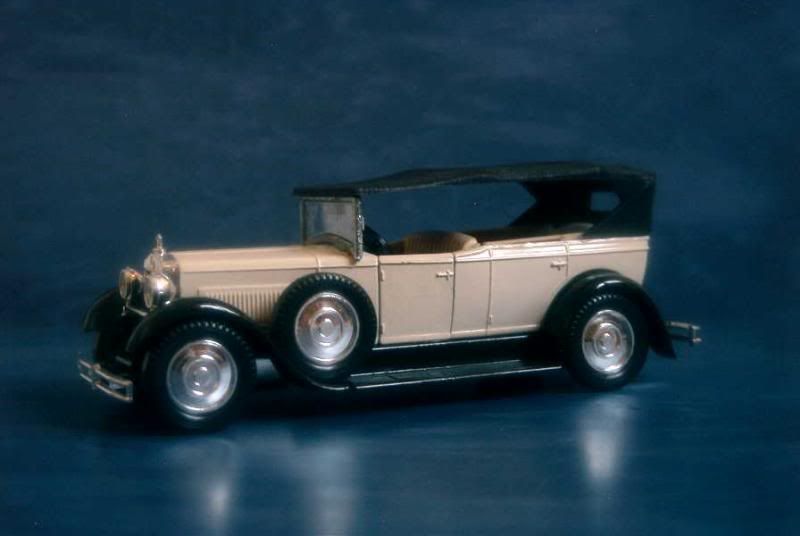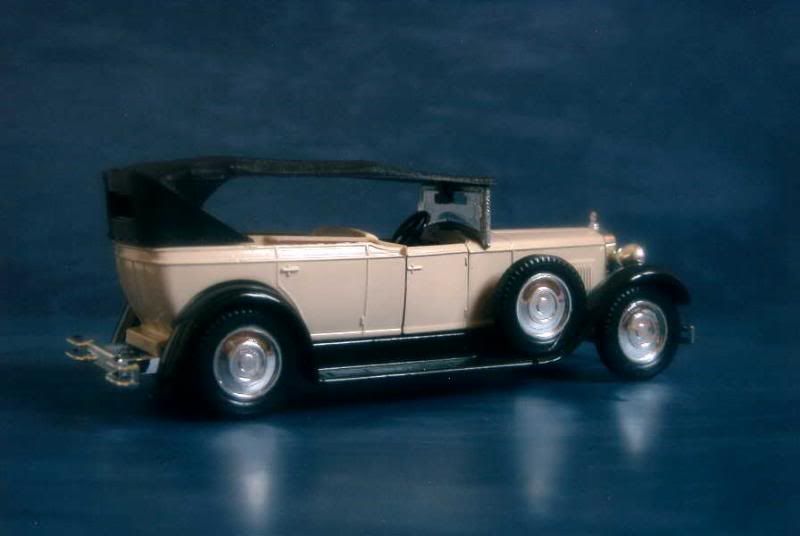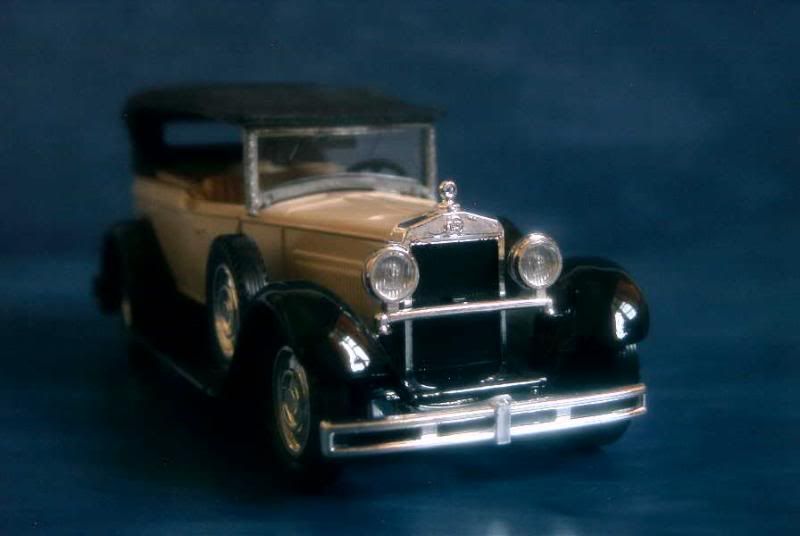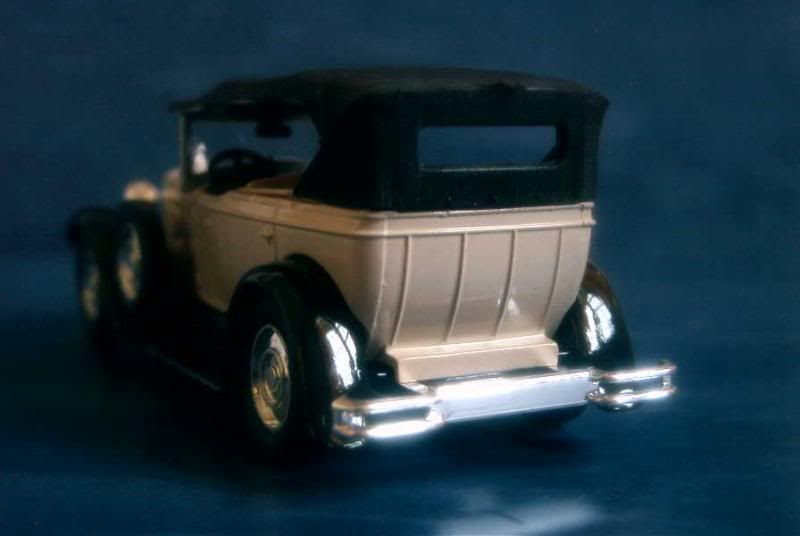A little history
Fiat has always been particularly renowned for its popular cars but, throughout its history, has also built automobiles for the more affluent. Indeed, for most of its existence Fiat has occupied the whole Italian market, except for the rather exclusive models sold by Lancia or Alfa Romeo.
During the Twenties, its middle range was held by its 507 model, a large four which had evolved from the earlier 505. By 1927, the 507 was due for retirement, and left its place to a new 520. Quite a conventional car, the 520 received nonetheless a six-cylinder engine until then reserved to the upper range 512 model. It also distinguished itself by the switch of the driver’s position from the right to the left of the car – though driving was on the right of Italian roads, cars as Alfa Romeo wouldn’t have their steering wheel mounted on this side until the early Fifties.
The 520’s six was a new 2.2-litre sidevalve block. Though roughly of the same displacement as the 507’s, it marked a sharp progress in performances, its output jumping from 35 to 46 bhp. Mechanical brakes were fitted to all four wheels – with the exception of the cheapest ones, no car could be offered anymore with brakes to only two wheels, as they still were a few years before. Rigid axles suspended by leaf springs were mounted both front and rear. Gearbox was an ordinary four-speed, non-synchromesh unit. Well, to cut this description short, as I said above there was absolutely nothing revolutionary about the car.
Mostly produced as a saloon or, to a lesser extend, as a phaeton, the 520 sold well – it was indeed a good car which furthermore had no competitors on its home market. Designed as a family car, it also entered the taxi market in 1928, one year after its introduction, when a 520T version succeeded the car-for-hire version of the 501. The 520T received a smaller 1.9-litre engine that was specific to it; with only 35 bhp to set in motion this heavy landaulet, performances were mediocre but obviously its major priority was economy.
As early as 1928, a development of the 520 appeared as the 521, though the older model would be produced for one more year as a passenger car and until 1930 as a taxi.
The 521 existed in two guises: the 521C (for “Corto”), which was basically a 520 fitted with a larger 2.5-litre six good for 50 bhp, or the standard 521, which added a chassis extended by 24 centimetres. The stretched wheelbase allowed building bodies that were better balanced visually – the 520’s towering look was now out-of-fashion, as the trend had switched to American-styled automobiles that appeared longer and lower. Most mechanical elements were carried over from the 520.
In 1931, the 521 was replaced by the new 522, which received its predecessor’s six-cylinder engine but introduced such technical refinements as hydraulic brakes and synchronised third and fourth gears.
About 40,000 Fiat 520/521s were built in Italy, shared equally between both models. In addition, about 13,000 more 521s were produced in Germany starting in 1930, becoming the first Fiat model constructed in the Heilbronn factory that had been bought the year before from local automobile and motorcycle manufacturer NSU.
About the model
Model: Fiat 521
Year: c.1928
Maker: Solido
Scale: 1/43
Distributed by: Solido, “Âge d'Or” series
Acquired: brand new, in December 2007, in Brive, France
Among the wide range of classic cars offered in scale by Solido, this Fiat is hardly the most popular, and I actually ignored it even existed until I spotted it on the shelf of a hypermarket. This very existence seems to contradict the reason so often heard that this or that model cannot be reproduced in die-cast because its profitability is doomed by too small a projected market: who’s really looking for a model of such a forgotten car?
This said, Solido’s model is rather simple, even to the company’s standards. Though I’m not one of these collectors who check the exact length of their models and compare it against the dimensions of the real car (respect of overall proportions, a word I often use, is for me much more important), I somewhat doubt about this model’s size – I’ll have to look for it in order to measure it, then I’ll update this post in that matter. In the meantime, my rating is 10/20.




Fiat has always been particularly renowned for its popular cars but, throughout its history, has also built automobiles for the more affluent. Indeed, for most of its existence Fiat has occupied the whole Italian market, except for the rather exclusive models sold by Lancia or Alfa Romeo.
During the Twenties, its middle range was held by its 507 model, a large four which had evolved from the earlier 505. By 1927, the 507 was due for retirement, and left its place to a new 520. Quite a conventional car, the 520 received nonetheless a six-cylinder engine until then reserved to the upper range 512 model. It also distinguished itself by the switch of the driver’s position from the right to the left of the car – though driving was on the right of Italian roads, cars as Alfa Romeo wouldn’t have their steering wheel mounted on this side until the early Fifties.
The 520’s six was a new 2.2-litre sidevalve block. Though roughly of the same displacement as the 507’s, it marked a sharp progress in performances, its output jumping from 35 to 46 bhp. Mechanical brakes were fitted to all four wheels – with the exception of the cheapest ones, no car could be offered anymore with brakes to only two wheels, as they still were a few years before. Rigid axles suspended by leaf springs were mounted both front and rear. Gearbox was an ordinary four-speed, non-synchromesh unit. Well, to cut this description short, as I said above there was absolutely nothing revolutionary about the car.
Mostly produced as a saloon or, to a lesser extend, as a phaeton, the 520 sold well – it was indeed a good car which furthermore had no competitors on its home market. Designed as a family car, it also entered the taxi market in 1928, one year after its introduction, when a 520T version succeeded the car-for-hire version of the 501. The 520T received a smaller 1.9-litre engine that was specific to it; with only 35 bhp to set in motion this heavy landaulet, performances were mediocre but obviously its major priority was economy.
As early as 1928, a development of the 520 appeared as the 521, though the older model would be produced for one more year as a passenger car and until 1930 as a taxi.
The 521 existed in two guises: the 521C (for “Corto”), which was basically a 520 fitted with a larger 2.5-litre six good for 50 bhp, or the standard 521, which added a chassis extended by 24 centimetres. The stretched wheelbase allowed building bodies that were better balanced visually – the 520’s towering look was now out-of-fashion, as the trend had switched to American-styled automobiles that appeared longer and lower. Most mechanical elements were carried over from the 520.
In 1931, the 521 was replaced by the new 522, which received its predecessor’s six-cylinder engine but introduced such technical refinements as hydraulic brakes and synchronised third and fourth gears.
About 40,000 Fiat 520/521s were built in Italy, shared equally between both models. In addition, about 13,000 more 521s were produced in Germany starting in 1930, becoming the first Fiat model constructed in the Heilbronn factory that had been bought the year before from local automobile and motorcycle manufacturer NSU.
About the model
Model: Fiat 521
Year: c.1928
Maker: Solido
Scale: 1/43
Distributed by: Solido, “Âge d'Or” series
Acquired: brand new, in December 2007, in Brive, France
Among the wide range of classic cars offered in scale by Solido, this Fiat is hardly the most popular, and I actually ignored it even existed until I spotted it on the shelf of a hypermarket. This very existence seems to contradict the reason so often heard that this or that model cannot be reproduced in die-cast because its profitability is doomed by too small a projected market: who’s really looking for a model of such a forgotten car?
This said, Solido’s model is rather simple, even to the company’s standards. Though I’m not one of these collectors who check the exact length of their models and compare it against the dimensions of the real car (respect of overall proportions, a word I often use, is for me much more important), I somewhat doubt about this model’s size – I’ll have to look for it in order to measure it, then I’ll update this post in that matter. In the meantime, my rating is 10/20.







No comments:
Post a Comment